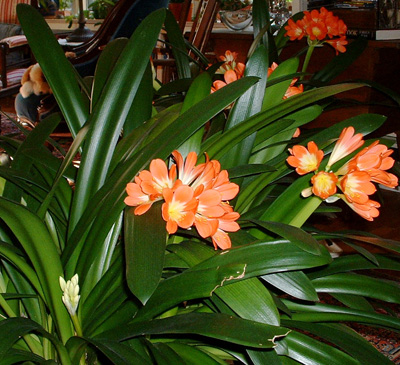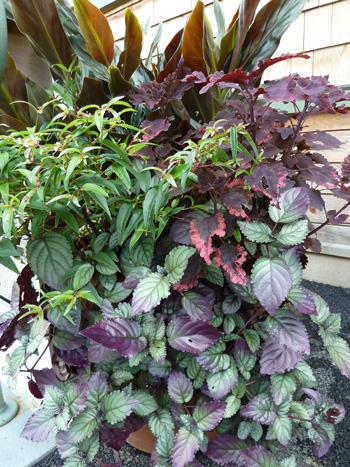Tropics in Philly

By Andrew Bunting and Becky Robert
This week the talk of the Philadelphia horticulture scene is the Philadelphia International Flower Show. This year’s theme Hawaii: Islands of Aloha, has gardeners dreaming of creating a tropical paradise in their own backyards. At the Scott Associates Spring Festival this weekend, members can choose between some wonderful tropicals to help create an island retreat in their gardens.
Our first option, Alpinia zerumbet ‘Variegata’, is a wonderful tropical plant grown for its bold strap-like foliage. The upright foliage has beautiful green and yellow variegation. It can grow in either sun or shade, but is particularly effective in shade where it will lighten a dark corner. It can be planted out in the garden or in a container in early May. It will grow to 3 feet tall in one growing season and should be brought in before the first hard frost in the fall.

Clivia miniata in bloom. photo credit: J. Downer
The bush lily or Kaffir lily (Clivia miniata) is an attractive houseplant from South Africa and another enchanting plant dividend this spring. It starts flowering in early spring with a round flower head of deep orange flowers and is a popular plant at the Philadelphia International Flower Show. It has wide, dark green, strap-like foliage. This group of dividends was given to us by Eleanor Ford. Her late mother, Betty Kassab, was a notable local plantswoman who cultivated the Kaffir lily to sell in her booth at the Flower Show. Clivia can be grown indoors during the fall and winter in part-sun to shade. It enjoys being outdoors for the summer (but not in full sun).

Hemigraphes alternata and Zingiber malayensis 'Midnight' are showcase in last years summer containers in front of the Wister Center. photo credit: J. Coceano
Zingiber malayensis ‘Midnight’ is a tropical plant dividend with fine, upright, shiny black foliage. Reaching 2 to 3 feet in a growing season it makes a perfect addition for the small garden or medium-sized container. The fine foliage points skywards and the leaves have a shiny lacquered effect. It combines beautifully with light orange flowers or chartreuse foliage. It thrives best in part-sun to shade. It can be planted in the garden by early May and should be harvested before the first hard frost in the fall.
For those members who enjoy our spring staple, the Forsythia, we are offering Forsythia suspena as a fourth dividend choice. This cascading species of Forsythia is perfect for planting on top of a wall or bank where it will spill forward. Like other forsythias it is covered with an abundance of golden-yellow flowers in late winter, usually blooming at the end of March in Swarthmore. It is planted on the wall in the Nason Garden and on top of a wall in the Wister Center parking lot. In both instances it helps shroud a utilitarian-looking wall. It will thrive best in full sun.
Join us Sunday, March 11 at 4 pm at the Lang Performing Arts Center to hear talented horticulturist, William Cullina, the 2012 recipient of the Scott Medal and Award speak about issues he is passionate about and how these passions have shaped his life. Member can select their dividend during the reception following his presentation. To shop for more plants to create the tropics in your garden, attend our Unusual Tropicals and Annuals Sale on May 18 to 20.





No Comments